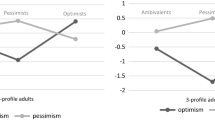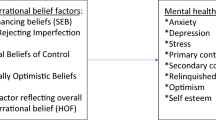Abstract
This study tested the hypothesis that the moderate correlation between optimism (O) and pessimism (P) scores (their non-bipolarity) found in earlier studies may be an artifact of the differential sensitivity of O and P items to two response sets: defensive pessimism and Pollyannaism. The data failed to support either component of the hypothesis. Thus, defensive pessimists, as measured in two quite different ways, had lower depression scores (BDI) than genuine pessimists, but contrary to prediction, had higher depression scores than optimists. Moreover, deleting P items with a strong defensive quality from the P scale failed to increase the correlation between O and P scores. Similarly, controlling Pollyannaism by a partial correlation procedure failed to increase the strength of the relation between O and P. The results in general support the notion that optimism and pessimism are not polar opposites.
Similar content being viewed by others
References
Abramson, L. Y., Metalsky, G. I., & Alloy, L. B. (1989). Hopelessness depression: A theory-based subtype of depression.Psychological Review, 96, 358–372.
Abramson, L. Y., Seligman, M.E.P., & Teasdale, J. (1978). Learned helplessness in humans: Critique and reformulation.Journal of Abnormal Psychology, 87, 49–74.
Beck, A. T., & Beck, R. W. (1972). Screening depressed patients in family practice: A rapid technique.Postgraduate Medicine, 52, 81–85.
Beck, A. T., Weissman, A., Lester, D., & Trexler, L. (1974). The measurement of pessimism: The hopelessness scale.Journal of Consulting and Clinical Psychology, 42, 861–865.
Bem, S. L. (1974). The measurement of psychological androgyny.Journal of Consulting and Clinical Psychology, 42, 155–162.
Cloninger, C. R. (1987). A systematic method for clinical description and classification of personality variants.Archives of General Psychiatry, 44, 573–588.
Cropley, A. J., & Weckowicz, T. E. (1966). The dimensionality of clinical depression.Australian Journal of Psychology, 18, 19–25.
Dember, W. N., & Brooks, J. (1989). A new instrument for measuring optimism and pessimism: Test-retest reliability and relations with happiness and religious commitment.Bulletin of the Psychonomic Society, 27, 365–366.
Dember, W. N., Martin, S. H., Hummer, M. K., Howe, S. R., & Melton, R. S. (1989). The measurement of optimism and pessimism.Current Psychological Research and Reviews, 8, 109–119.
Dember, W. N., & Penwell, L. (1980). Happiness, depression, and the Pollyanna principle.Bulletin of the Psychonomic Society, 15, 321–323.
Fischer, M., & Leitenberg, H. (1986). Optimism and pessimism in school-aged children.Child Development, 57, 241–248.
Frauenfelder, K. J. (1974). A cognitive determinant of favorability of impression.Journal of Social Psychology, 94, 71–81.
Gonen, J. Y. & Lansky, L. M. (1968). Masculinity, femininity, and masculinity-femininity: A phenomenological study of themf scale of the MMPI.Psychological Reports, 23, 183–194.
Hummer, M. K. (1990).The differential vulnerability of optimism and pessimism to response sets. Unpublished doctoral dissertation, University of Cincinnati, Cincinnati, OH.
Kamen, L. P., Rodin, J., & Seligman, M.E.P. (1987).Explanatory style and immune functioning. Unpublished manuscript, University of Pennsylvania, Philadelphia, PA.
Kanfer, F. H., & Schefft, B. K. (1988).Guiding the process of therapeutic change. Champaign, IL: Research Press.
Kent, D. (1990). Optimists and pessimists, both have their place.American Psychological Society Observer, November, 18–19.
Kettelaer, T., & Sinnett, L. M. (1990). The relation between positive and negative affect and optimistic and pessimistic judgments: A mood congruency model. Paper presented at the Annual Meeting of the American Psychological Society, Dallas, TX.
Martin, S. H. (1986).Optimism, pessimism and psychological defense. Unpublished master’s thesis, University of Cincinnati, Cincinnati, OH.
Matlin, M. W., & Stang, D. J. (1978).The Pollyanna principle. Cambridge, MA: Shenkman.
Newman, M. K. (1983).The measurement of optimism/pessimism. Unpublished master’s thesis, University of Cincinnati, Cincinnati, OH.
Norem, J., & Cantor, N. (1984).Pessimism as a cognitive cushion. Paper presented at the Annual Meeting of the Midwestern Psychological Association, Chicago, IL.
Norem, J., & Cantor, N. (1986). Anticipatory and post-hoc cushioning strategies: Optimism and defensive pessimism in “risky” situations.Cognitive Therapy and Research, 103, 346–356.
Osgood, C. E., Suci, G. T., & Tannenbaum, P. H. (1957).The measurement of meaning. Urbana, IL: University of Illinois Press.
Peterson, C., Seligman, M.E.P., & Vaillant, G. E. (1988). Pessimistic explanatory style as a risk factor for physical illness: A thirty-five-year longitudinal study.Journal of Personality and Social Psychology, 55, 23–27.
Peterson, C., & Villanova, P. (1988). An expanded attributional style questionnaire.Journal of Abnormal Psychology, 97, 87–89.
Scheier, M. F., & Carver, C. S. (1985). Optimism, coping and health: Assessment and implications of generalized outcome expectancies.Health Psychology, 4, 219–247.
Schwab, M. D. (1984).Optimism, depression, and task expectancy. Unpublished master’s thesis, University of Cincinnati, Cincinnati, OH.
Seligman, M.E.P., Nolen-Hoeksema, S., Thorton, N., & Thornton, K. M. (1990). Explanatory style as a mechanism of disappointing athletic performance.Psychological Science, 1, 143–146.
Spence, J. T., & Helmreich, R. L. (1978).Masculinity and femininity: Their psychological dimensions, correlates, and antecedents. Austin: University of Texas Press.
Terezis, H. C. (1990).Optimism and pessimism: Manipulation via musical mood induction. Unpublished master’s thesis, University of Cincinnati, Cincinnati, OH.
Winer, B. J. (1971).Statistical principles in experimental design (2nd ed.). New York: McGraw-Hill.
Zullow, H. M., Oettingen, G., Peterson, C., & Seligman, M.E.P. (1988). Pessimistic explanatory style in the historical record: CAVing LBJ, presidential candidates, and East versus West Berlin.American Psychologist, 43, 673–682.
Author information
Authors and Affiliations
Rights and permissions
About this article
Cite this article
Hummer, M.K., Dember, W.N., Melton, R.S. et al. On the partial independence of optimism and pessimism. Current Psychology 11, 37–50 (1992). https://doi.org/10.1007/BF02686826
Accepted:
Issue Date:
DOI: https://doi.org/10.1007/BF02686826




